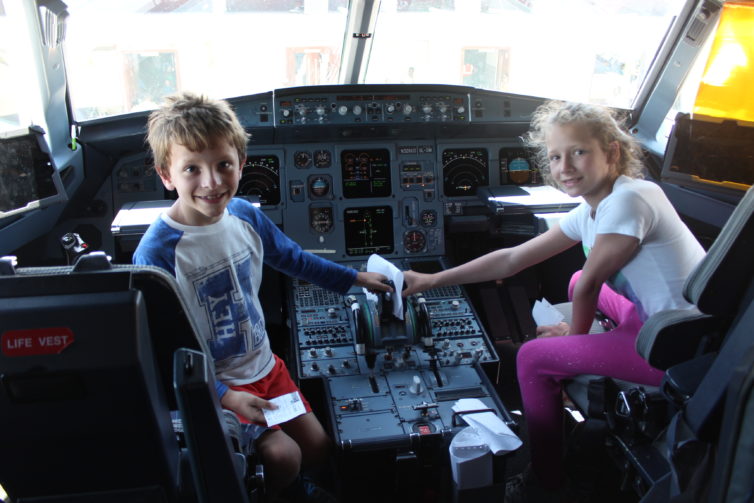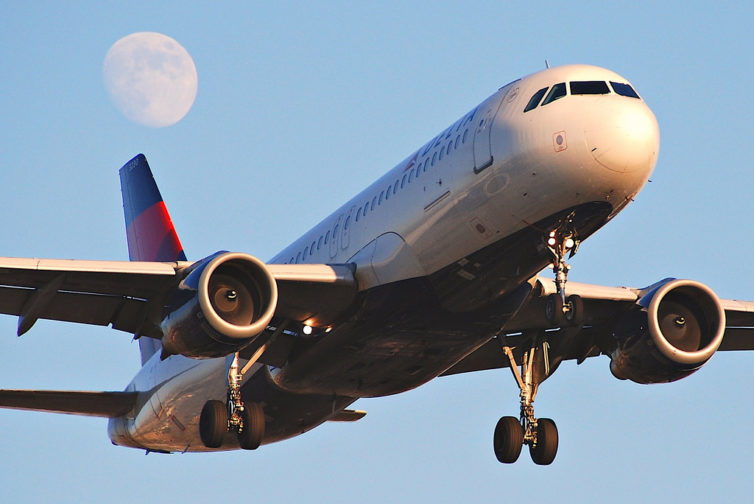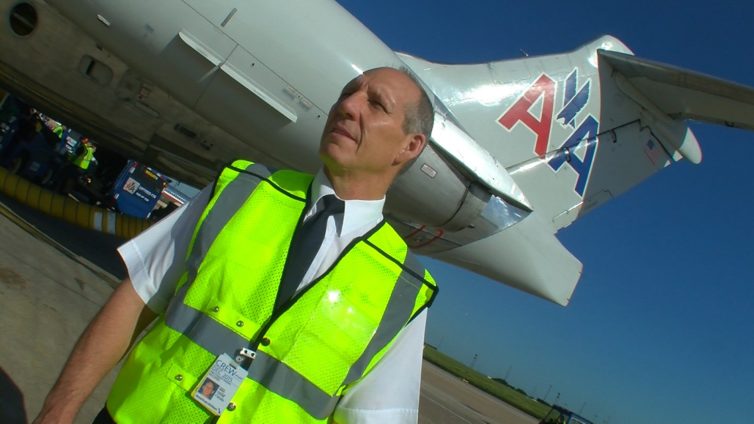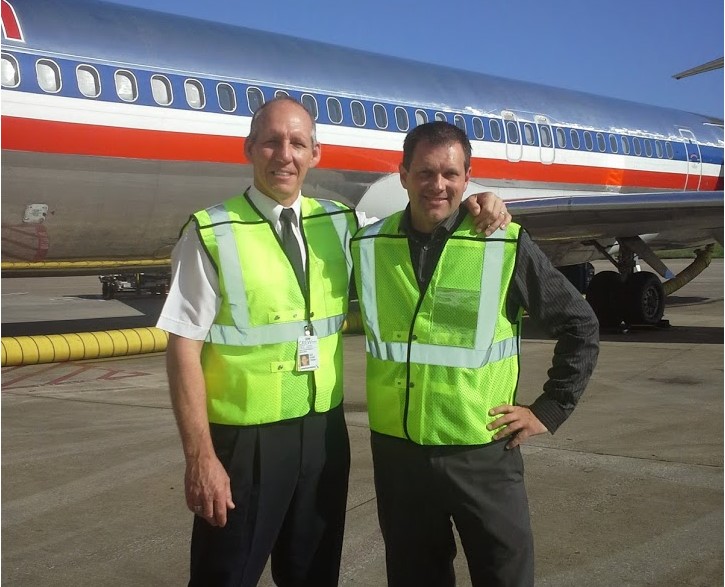
My kiddos aboard an Airbus A320, thanks to a gracious Delta first officer
Knowing you’re in good hands is more than an insurance company slogan, it is a daily practice for the talented men and women who fly millions of people safely around the globe on a daily basis. So instead of complaining about the legroom or snack selections on board, please take a minute and and thank your pilots (hey, don’t forget the flight attendants too).
Less than 24 hours after the engine explosion that killed one person on Southwest Airlines flight 1380, I boarded an airplane with my two children for an international flight back home. The kiddos (11 and 8) heard a little news about the incident, but I intentionally did not give them all the details so they wouldn’t get worried as we had two flights with a combined eight hours in the air that day.
As soon as we boarded, the first officer immediately said hello to my kids and quickly offered them a look up front. The kids were game and their AvGeek dad was more than willing to check out the flight deck of the Delta Air Lines A320 that would be safely getting us back to the USA. That kind gesture took away any nervousness I had about flying that day.
Being the former TV news reporter, it’s habit to ask him lots of questions – which planes he’s flown, Airbus or Boeing, and what one is his favorite. The thing that stuck out about the chat was his mentioning flying a KC-10 refueling tanker for the Air Force.

A Delta Airbus A320 – Photo: Aero Icarus | FlickrCC
When I asked him if flying a civilian plane must be quite boring compared with the military, he smiled and said ’œno, at least here there’s less chance of getting shot at.’ Good point. If he handled military combat zones in a big plane filled with fuel, then getting into Atlanta should be a piece of cake!
It is not rare to find veteran pilots, like the one I recently met. The Air Line Pilots Association reports 44 percent of Delta Air Lines pilots have served in the military.
Tammie Jo Shults was in the left seat when she made the emergency landing on SW 1380. She is also a veteran and one of the first women to ever fly a Navy F/A-18 fighter jet. For those with an urban dictionary, that’s considered ’œbadass!’ She and her first officer deserve the talk show appearances, book deals, and speaking fees that come with such a feat.
My appreciation for pilots came during a TV news story 20 years ago. I had the honor of showing the training Air Force B-1 bomber pilots go through and got to fly with them on a training mission. I spent an entire day with them before the flight, going over their flight plan and doing all the ’œregress training’ required in case there was an emergency. Pilot Maj. Kevin McCandless was at the controls that day and was as good as they come. Today he’s in the left seat of an MD-11 for FedEx.
HOP INSIDE A B-1 BOMBER! Here’s selected raw video from my flight with Maj. McCandless and the dedicated USAF crew back from a 1998 story.
The thing that struck me during the pre-flight was the calmness and professionalism they displayed. They went over the flight plan back and forth and it was clear these guys knew the drill (or darn showed it since there was a TV camera in the room) I wasn’t a bit nervous hopping aboard because these guys were so cool and capable. We did an in-air refueling and they made it look easier than most people pulling up at a corner gas station, no less one that’s flying in the air.
Stop and think about how talented you have to be to fly a military aircraft and all the training required. Then tack on the idea of flying in hostile territory and it’s a safe bet you’re in mighty good hands if your pilot has served our country. More good news: a large number of air traffic controllers also have a military background. If they can figure out how to get planes in and out of an Iraqi desert, certainly O’Hare or LAX can’t be that bad?
Training for non-military pilots is extensive too, including years spent at smaller regional airlines before getting the call to the big leagues, or ’œmainline’ as they say in the industry.

Two-time NHL all-star, current American Airlines Captain Al Secord – Photo: Brian DeRoy
One pilot I met has played in two big leagues. Al Secord was a 1978 first-round draft choice in the National Hockey League and played 14 years in the pros. In the early 80’s he was a feared opponent, racking up 94 goals and nearly 500 penalty minutes in just two seasons. He was hated by so many teams that fans would often chant ’œSecord Sucks’ when his Chicago Blackhawks took the ice. He told me the ’œSecord Sucks’ chant was an honor, that meant he was making a difference and helping his team. No one would bother chanting about someone sitting on the bench not doing anything, right?
Secord earned two NHL All-Star game appearances, getting to skate with Wayne Gretzky.
After hanging up the blades and likely icing down his knuckles (he played when fighting in hockey was a lot more common), Secord took up another passion in life: flying. Breaking into aviation doesn’t have a draft or high-powered agents; he had to train and learn like everyone else. He spent six years at regional airlines before getting the call to the big leagues with American Airlines. He worked his way up from first officer of an MD-88, to captain of a 737. April marks his 20th year with American, six more than he played in the NHL.

Have you thanked your pilot today? – Photo: American Airlines
I met him while working with Boeing (click here to see the story and video feature) and found his passion for flying equal to his love of hockey. He shares a love of flight with his wife Tracy, who also flies for American. Guess where they met? Yep, flight school! Al and Tracy Secord are currently based out of Dallas.
Whether your pilot was a military fighter jet commander, a pro hockey all-star, or worked their way through the piloting ranks, stop and thank them for a job well done. They’ve spent a lot of time and money training, and work weekends, holidays, and early mornings to get you safely to your destination. We hope they don’t have to take heroic action like Captain Shults did recently, but if things get dicey we know they’re ready for anything.
And if you see Captain Secord, lay off the ’œSecord Sucks’ chant. Hockey is only a game and he’s on your team now!
unique flight experiences include an Air Force B-1 Bomber